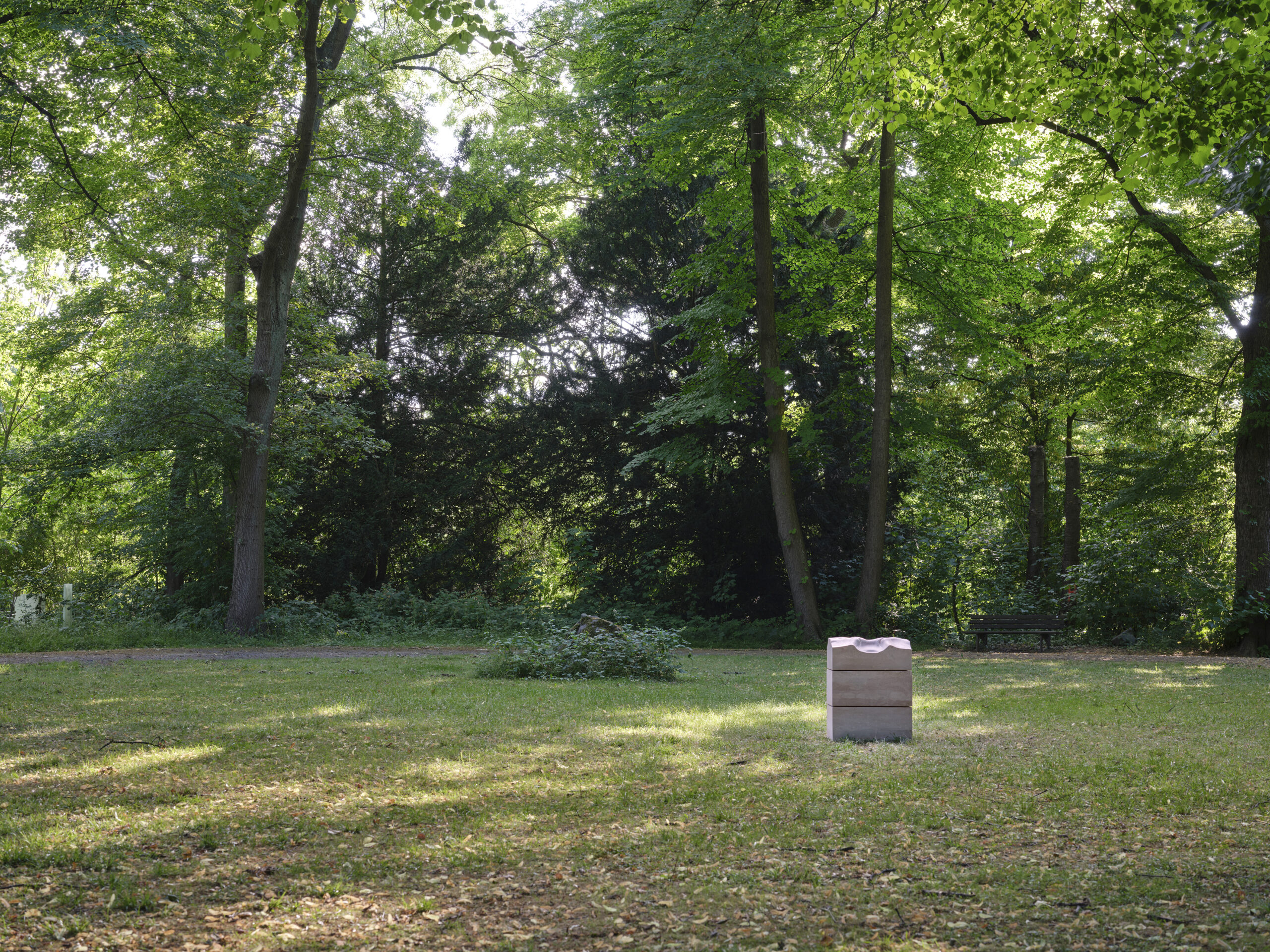Benjamin Hirte
Speaker of the House, 2024
Untersberger Marmor
3-teilig, jeweils 54 cm x 63 cm x 27 cm, Gesamtmaße 54 x 63 x 81 cm
Courtesy der Künstler und Galerie Emanuel Layr
Scroll down for the English version
Benjamin Hirtes Speaker of the House besteht aus drei aufeinander gestapelten Elementen Untersberger Marmor.
Eine Anordnung stummer Steine, in deren Schichten sich ineinander verflochtene Verweise überlagern. Die Vertiefungen und Erhebungen erinnern an Körperfalten oder geologische Formationen, während scheinbar funktionale Aussparungen und armaturenbrettartige Rundungen an modellierte und industriell gefertigte Komponenten erinnern. Der für die Skulptur verwendete Untersberger Marmor ist ein in Österreich gewonnener Kalkstei — ein Material, das im 17. Jahrhundert insbesondere für Bauten, Architekturelemente und Skulpturen verwendet wurde.
In unmittelbarer Nähe eines großen Zierfelsen in der historischen Lindenallee platziert, findet Speaker of the House einen Nachhall in den Überresten
von Skulpturen, die zur Gründung des Parks durch die Familie Lantz bzw. Carl Friedrich Julius Bouché, der den hinteren Gartenteil 1880 gestaltete, aufgestellt wurden. Manche existieren heute nur noch in Fragmenten, erkennbar lediglich anhand leerer Steinsockel oder überwachsener Podeste. In diesem Umfeld verweist Speaker of the House
darauf, wie selbst scheinbar ruhendes Material von historischen, sozialen und politischen Sedimenten durchzogen sind, die zu ihrer Formwerdung beigetragen haben.
Benjamin Hirte (geb. 1980 in Aschaffenburg) lebt in Wien und Berlin. Einzelausstellungen u.a. im MAK Center, Los Angeles; Kevin Space, Wien; Museo Canonica, Rom; und Zollamt – MMK, Museum für moderne Kunst, Frankfurt präsentiert.
Benjamin Hirte’s Speaker of the House features three stacked pieces of Untersberg marble that form both an assembly of mute stone and complex strata of references. In its recesses and elevations, it recalls bodily folds or geological formations, while seemingly functional cutouts and dashboard- like curvatures suggest a modelled and manufactured component.
The sculpture’s Untersberg marble is a limestone sourced in Austria and is a historically charged material, given its particular use in 17th-century buildings, architectural elements and sculptures. Placed in the immediate vicinity of a large ornamental rock in the historical Linden allee, Speaker of the House resonates with the remnants of the historical sculptures that were placed in the park at the time of its founding by the Lantz family and Carl Friedrich Julius Bouché respectively, who designed this part of the
park in 1880. Some of them exist only in fragments today, discernible merely through empty stone plinths and pedestals. Situated in these surroundings, Speaker of the House points to how even dormant materials are sedimented with the historical, social and political frameworks that initially formed them.
Benjamin Hirte (b. 1980 in Aschaffenburg, Germany) lives in Vienna and Berlin. Hirte’s work has been shown in solo exhibitions at MAK Center, Los Angeles; Kevin Space, Vienna; Museo Canonica, Rome; and Zollamt – MMK, Museum für moderne Kunst Frankfurt among others.


